|
1.
CENTRAL/ WEST AFRICA
Log prices relatively stable
The overall movement of logs was more positive due to the implementation of Congo¡¯s log quota
system, which significantly cut log exports. This has kept prices relatively stable, reducing pressure on producers by
removing substantial volumes from the market.
Despite this movement of logs, log stocks of West African species in China were still high and
mostly of lower grade species. Consequently, log shipments to China were still
heavily restricted. Okume had been the species worst hit by this trend, although premium species were less
affected. Producers continued to look for alternative markets for okume, even to North African and European
destinations.
Sipo and sapele logs were in demand for all markets and prices for these species were higher. For
sawn lumber, sipo and sapele had notable price hikes while all other species were firm in May.
Although there remained some nervousness in the market, producers had been able to diversify
markets and hold most prices stable. Major okume producers faced the biggest problem, but had yet to reduce prices.
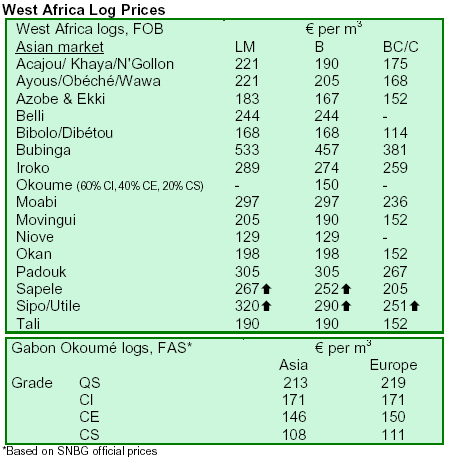
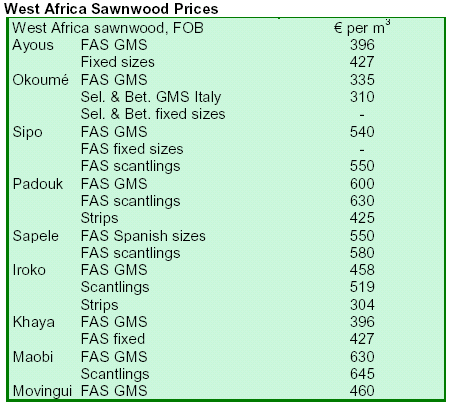
2. GHANA
New headquarters for Ghana¡¯s Forestry Commission
Ghana¡¯s Forestry Commission relocated to a new office complex, at West Legon in Accra, from its previous
headquarters in Accra. The move would be fully complete with the relocation of two other
divisions, Wildlife and Forest Services, at the end of June.
Ghana strikes oil
A huge oil field containing about 600 million barrels of light oil had been discovered in Ghana. After 20 years of
exploration, London-based Tullow Oil Plc. announced on 18 June that a discovery had
been made off the coast of Cape Three Point in the Western region of the country.
Commercial production was expected to begin in seven years. The discovery was made jointly by Kosmos
Energy (USA), Tullow Ghana and the Ghana National Petroleum Company (GNPC).
Ghana introduces new Ghanaian Cedi (GH¡é)
As of 1 July 2007, the Bank of Ghana would replace its currency (¡é) with Ghanaian Cedis (GH¡é). The new
currency would be equivalent to ¡é10,000 and represent no change in the value of funds
held in cash, checks or in bank funds. The old currency would be used and valid for
business transactions until 31 December 2007.
Ghana celebrates 50th year of independence
Ghana celebrated its 50th year of independence and the country¡¯s outlook remains upbeat. The
country has reaped the benefits of the Kufuor administration¡¯s reforms, high
commodity prices, monetary stabilization and debt relief. Ghana registered one of the strongest GDP growth rates in
Africa, with annual GDP growth of 4.7% over the last twenty years. GDP growth reached 6.2% in 2006, its
highest since 1992, and driven mainly by agriculture, mining and construction. Rising
investment contributed to growth, and debt relief should enable the government to
increase capital expenditures.
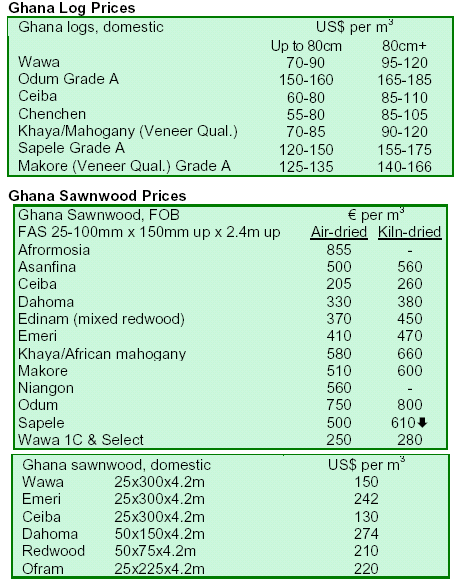
3.
MALAYSIA
MTCC speaks out on Dutch timber tester¡¯s ruling
The Malaysian Timber Certification Council (MTCC) has issued a statement in response to a ruling by the Dutch
timber tester Keurhout. The Keurhout Board of Appeal (BoA) recently ruled that it
would withdraw its legal certificate for an individual company using the MTCC
scheme, following an appeal by Greenpeace. MTCC said the BoA had considered six points, four of which were in
favor of Greenpeace¡¯s appeal. Of the four points, two were related to approving individual MTCC certificates, rather
than recognizing the MTCC scheme as a whole. The MTCC is concerned that press reports of the event and the
ruling itself may give the wrong impression to the UK and its timber customers that the MTCC scheme is not able to
comply with the Keurhout Protocol of the Validation of Claims of Legal Timber
(KH-LET).
MTCC expressed surprise by the BoA ruling, which claimed that an independent accredited
assessor was not verifying the MTCC chain of custody (CoC) in the Netherlands, even though part of the assessment has
covered by Keurhout¡¯s own CoC system. Malaysia also uses SGS (Malaysia) as its national accreditation body and
adheres to ISO guidelines, which the Keurhout protocol accepts. As of February 2007, the Dutch government
accepted the MTCC certification scheme as part of its new public procurement guidelines. MTCC hopes that the
Keurhout Board of Experts can accept the MTCC scheme as a whole, which the MTCC claims would be in line with
other international practices.
Minister expects robust performance of timber industry
Plantation Industries and Commodities Deputy Minister Datuk Anifah Aman said he expected the Malaysian
timber industry to benefit from a Voluntary Partnership Agreement (VPA) with the
EU. As a result of the agreement, the Deputy Minister suggest a robust performance could be expected from Malaysia¡¯s timber
industry this year.
Anifah noted that the timber industry continued to be a major export earner, contributing RM23.44 billion in
2006, an increase of some 19% from the previous year. The impressive performance was envisaged to continue in
line with the increased use of timber in the local construction industry. Prices of plywood, however,
remained steady as Japan's industrial production unexpectedly fell in May from a month earlier, casting
doubt on an anticipated rebound in output.
Malaysian exporters keep focus on Middle East boom
Malaysian timber products manufacturers are continuing to focus on the Middle-East, as the UAE experiences its
fastest growth in modern history. The latest company to benefit from the boom was Tameer Holding, the region¡¯s
leading real estate development company. The company has signed a AED605 million agreement with Arabian
Construction Company (ACC) to be the main contractor of ¡°Elite Residence,¡± one of Tameer¡¯s prestigious projects
situated in Dubai Marina.
The Elite Residence may become one of Dubai Marina¡¯s most striking landmarks, as it covers an area of 1,461,310 sq. ft., and has 91 levels with 82 residential floors, four car
parking floors, four basements and a height of approximately 380m. Although Malaysian contractors so
far have limited success in the Middle-East, Malaysia¡¯s exports of timber products have fared well through
jointventures with local companies in the UAE.
Prices for wooden furniture remain unchanged
Prices of Malaysian wooden furniture products remained unchanged as US mortgage applications fell for a second
straight week and interest rates remained near recent highs. The US continued to be the largest market for
Malaysian furniture and related products. In addition, with the Malaysian currency appreciating against the US
dollars, Malaysian furniture exporters might be forced to absorb additional cost to maintain their customer base.
Technology drives plywood production in Malaysia
The publication FDM Asia explained the reasons behind the massive plywood expansion between 2000 and 2006.
Growth during this time was in excess of 10% per annum in the South Asian region, and was largely attributed to
government incentives and legislation used to curtail exports of unprocessed wood products. Plywood
contributed nearly 65% of total production capacity of wood based panels in 2006, and had replaced Indonesia as
the largest tropical exporter in the world.
At the same time, figures suggested plywood production was being overshadowed by newer
products, such as oriented strand board and laminated veneer lumber, and further complicated by dwindling supplies of large
diameter logs. Since producers had been turning to smaller diameter logs and lesser used species, improvements were
necessary along the manufacturing line. Although Western technology continued to dominate production of plywood
in Asia, indigenous technologies, especially in China, had been rapidly developing. In order to keep pace with rising
global demand for tropical plywood, further technological innovation was required to maintain a
competitive edge in the region.
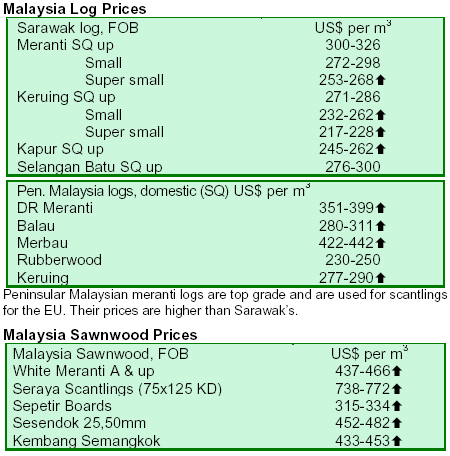

4.
INDONESIA
Dutch associations commit to using FSC timber from Borneo
A total of 100,000 houses are to be built from FSC certified timber from Borneo as part of a
commitment by Dutch housing associations. The initiative was jointly sponsored by the FSC
Netherlands, WWF-Indonesia, Woonbron and several others in the Dutch housing sector
and was designed to ensure all housing associations would use sustainably managed timber and timber
products. Thus far, FDM Asia reports that 38 corporations in Dutch housing associations have
agreed to build 100,000 houses, or 25% of the total number of houses to be built over the
next five years.
Indonesian company feels impact of log freight rates
Indonesian interests have entered into discussion with Rayonier New Zealand Inc. about handling
the primary processing of logs in New Zealand. The Indonesian interest in setting up sawmills in
New Zealand has been driven by a worldwide shortage of ships for freighting logs, pushing up
transport costs. This, in conjunction with the pending Russian log export tariff, has been causing
concern among East Asian timber processors, which are contemplating long-term supply
contracts, said Mr. Paul Nicholls, Rayonier's Managing Director of Asia-Pacific
Forest Resources.
Meanwhile, freight rates for logs are skyrocketing because the booming Chinese economy has
been causing a scarcity of bulk carriers for logs. Since container freight rates have
not gone up to the same extent as log freight rates, Asian processors may do their initial processing in New
Zealand and send the dried sawn timber back in containers for further processing. New Zealand
Forest Owners Association president Peter Berg said it would be an interesting and logical
development.
Indonesia and Australia to hold talks to consider FTA at APEC Summit
Indonesia and Australia are inching towards talks on freer trade, as the imminent collapse of global reform talks puts
a greater focus on regional deals. The APEC summit to be held in Sydney in September is expected to provide a
venue for talks between John Howard and Indonesian President Susilo Bambang Yudhoyono on a feasibility
study for a free trade agreement.
In recent times, global concerns over climate change have improved Indonesia¡¯s relationship with
Australia. Australia is looking to finance Indonesian programs fighting deforestation and promoting development of
plantation timber. Exports from Australia are dominated by minerals, petroleum, meat, and paper.
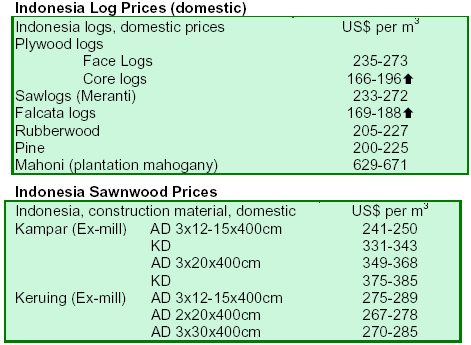
5.
MYANMAR
Teak logs enjoy sustained robust demand
Demand continued to be strong for teak logs. Teak prices remained firm throughout 2006 and during
the first six months of 2007. The annual sale of teak logs by tender was about 33,000 Hoppus tons
in 2006, while the direct sales against Myanmar Timber Enterprise (MTE) list price
were estimated to be more than 200,000 Hoppus tons. While the tonnage sold monthly by tender was
comparatively small, the tender average prices had a significant influence on the teak market. When teak logs
obtained from direct sale contracts had been traded in the market, the resale prices were adjusted similarly. MTE
could increase its direct sale prices to suit the trend.
Demand for sawn teak was also strong. With a smaller quantity being made available to the
saw-millers in Myanmar, the quantity exported had been quite the reverse. Interested parties
maintain that now is a good chance to add impetus to the development of the Myanmar
wood industry by supplying more industrial raw logs.
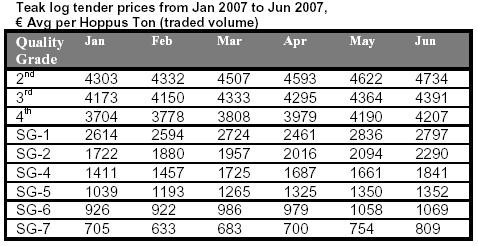
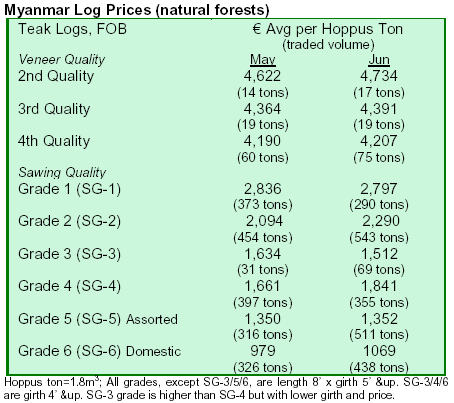
While prices for Gurjan logs are still selling well, buyers
believe demand will change as the rainy season advances.

6. BRAZIL
Bank of Brazil raises interest rate by 0.5 points
The Central Bank of Brazil reduced the prime interest rate by 0.50 percentile points, resulting in an
annual rate of 12.5%. Brazil¡¯s Consumer Price Index (IPCA) in May 2007 recorded inflation at
0.28% while in the previous month, the index was 0.26%. In May, the average exchange rate was BRL2.25 to USD1.
State of Amazonas backs law against illegal wood
The consumption of illegal logs from the Amazon forests for construction of public works has been negligible for
nearly three years, since the former Forest Agency AFLORAM established the ¡°green stamp¡±.
AFLORAM, which has been incorporated by AGROAMAZON, has created the ¡°green
stamp¡±, a certification that recognizes the legal origin of wood used in public construction
statewide. While the stamp has been widely used, neighboring states of Para and Mato Grasso
have yet to enforce the use the ¡°green stamp¡±. According to the Secretary, despite the existence of the ¡°green stamp¡±, over
70% of the current log production still comes from illegally felled timber and illegal selective cuts.
Since not all states were using the ¡°green stamp¡± in the Amazonas, the publication Amazonas Em Tempo said the
Senate would pass a law forbidding states from using wood for federal construction sites if the wood did not
have a ¡°green stamp¡±. The state government of Amazonas would support the initiative if approved. If the measure is
passed, Brazil would have the opportunity to eliminate illegally felled wood from all federal public works bids.
Additionally, to help control the consumption of illegal wood in public works, the State Secretary of the
Environment and Sustainable Development maintains a website.
The Amazonas lumber industry produces 10.4 million m3/annum of sawnwood and veneer. Most of the region¡¯s
wood production (64%) caters to the Brazilian market and public agencies consume
large volumes of wood for public works and services.
New furniture cluster launched in Maranhao
The city of Buriticupu, about 300 km from Amazonas¡¯s state capital Sao Luis, would host nearly 60 furniture
producers. According to Portal Moveleiro, the furniture cluster was launched on 12 June,
during a seminar organized by the Brazilian Support Service to Micro and Small Companies
(SEBRAE), with support from the Public Prosecution Office of the Justice of
Buriticupu, City Hall, and the Furniture Producers Association of Buriticupu. According to the Buriticupu Public
Prosecution Office, the construction of the furniture cluster was a result of a Term of Behavior
Adjustment (TAC) agreed to with the Municipal administration. The TAC required that furniture
companies mitigate health concerns for those working in the furniture industry area.
It also prevented the city from granting licenses to new companies and allowed the acquisition of land
outside the urban perimeter to become a part of the Buriticupu furniture cluster.
Brazil chalks higher wood exports in May
Brazilian exports of most wood products, plywood and sawnwood increased during May. Notably, exports of
tropical sawnwood rose 70% from the previous year.
Last January, Brazil¡¯s Ministry of Foreign Affairs adopted new guidelines for grouping products in export records.
The charts below show the trends in Brazilian exports, based on the new grouping methods, from the period
January ¨C May 2006 compared to the same period in 2007.
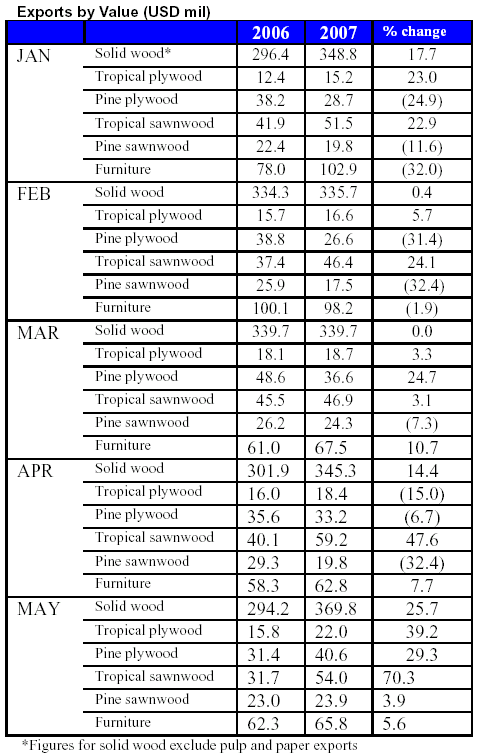
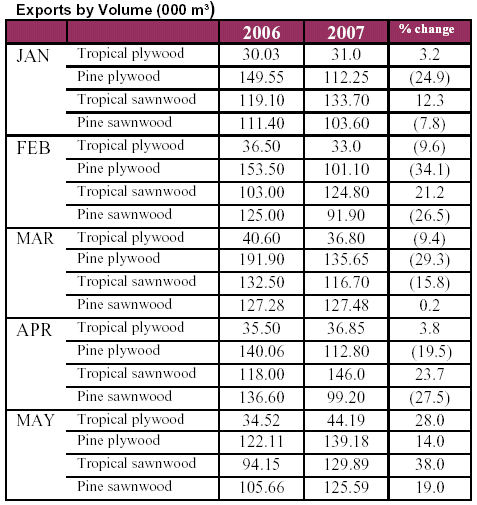
B&Q policy on certified Brazilian timber
B&Q, the third largest retail chain of construction and decoration materials in the world, announced that within
three years, all Brazilian wood products sold in China would be certified. The certification scheme was being
sponsored by the Certified Forest Products Buyers Group, Friends of the Earth
¨C Amazonia, in an attempt to maintain Amazonia¡¯s large market share in China. According to
data from Greenpeace, which campaigned against the purchase of illegal Brazilian timber, China
consumed nearly 10% of Amazonian timber exported by Brazil. From 1999 to 2006, the volume of
products traded grew from 6,100 tons to almost 80,000 tons during the seven year period.
Considering the large representation of B&Q worldwide, the initiative had the potential to snowball.
Furniture exports stage strong recovery in June
According to CGI Moveis, Brazilian furniture exports in the first five months of 2007 reached
USD397 million, or a change of 10.5% compared to the same period in 2006. Despite the overall
rise, furniture exports to the US dropped 14.9% and sales totaled USD105.6 million.
However, June sales to the US were recovering, with an additional USD22 million reported
compared to sales in May 2007. Argentina purchased USD27.4 million worth of furniture in May, a 12% growth rate from April.
Germany also received 5% of Brazilian exports, with the total of USD17.7 million, up USD4 million from May
2007. Of the major Brazilian furniture producing states,
Rio Grande do Sul exported a total of USD108.3 million from January through May 2007, an
increase of 8.4% from 2006. Other top exporters were the Southern state of Santa
Catarina, which is responsible for 38% of the total exports, followed by Rio Grande do Sul with 28.0%, and Sao
Paulo with 13%. The state of Minas Gerais¡¯s exports rose 13.7%, or 5% from the month of May. On the other hand, the
northeastern state of Bahia decreased its exports by 2.5%.
An average increase of 2.3% in prices for wood products
was observed in June compared to prices presented in May. Prices in BRL increased 0.22% on average,
indicating that prices were not over the past month.
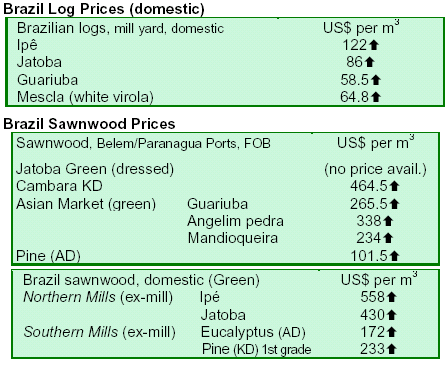
7. PERU
Ministry rules out additional benefits for investors
The Ministry of Agriculture indicated that there was no further need to grant additional tributary
benefits to promote forest investment in Peru, saying that current incentives were sufficient. The
Minister of Agriculture, Ismael Benavides, explained that Peru¡¯s law for promoting
private investment in reforestation and agroforestry already contained benefits for promoting forest activities.
He also noted that the law assigned state land forests by selling to private investors willing to direct their money to
reforestation and agroforestry activities. Even though the law allowed land concessions to be granted for 60 years,
investors showed a lack of interest in the incentives at present and called for more guarantees. Benavides said
that promoting reforestation would lead to closing the current gap between lumber exports and imports.
New system helps reduce illegal felling in Peru
The president of the National Forest Chamber, Ignacio Lombardi Indacochea, said illegal felling in
Peru had been reduced by 20%, mainly due to the new forest concession system applied since
2000 by the National Institute of Natural Resources (INRENA). Mr. Lombardi noted that
better records of logging units enabled increased control over forest felling. He indicated that that informal logging
of mahogany had been reduced by more than half the amount recorded in 2006.
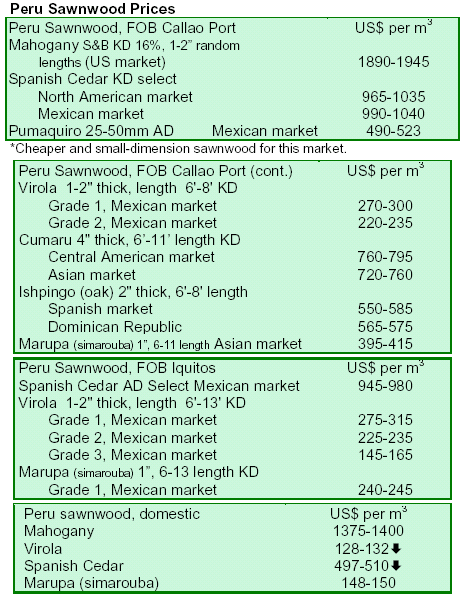
8. MEXICO
New native tree species discovered in Mexico
A new native tree species, Bursera simaruba, has been found in Mexico. The tree has a thin,
photosynthetic cover, which allows it to lose humidity in the process of photosynthesis. It has a height of 20 meters, with normal
diameters of up to 80 cms, and the trunk usually branches off at a height of 2 meters. The new species has in fact
been used for construction of rural houses, manufacturing centers for slanting wood, handles for tools and
agricultural implements, boxes and packing materials, matches and pulp for paper. The species can also be used
for the production of toys, rustic furniture, and in kitchens, since the dimensional stability is excellent. The resin that
exists in the trunk and the branches has been used in some regions as a substitute for glue, and used occasionally in
the production of lacquers and varnishes.
9.
GUYANA
Government defends guidelines for utilization of
natural resources
Minister of Agriculture Robert Persaud highlighted at the recent World Wildlife Fund¡¯s (WWF) sixth steering
committee of the ¡°Guianas Sustainable Forest Resource Management Project¡± that the
government had significantly invested in developing forestry guidelines. Current forestry guidelines
require that forest operations above 8,047 ha are to be undertaken on the basis of a
Forest Management Plan and annual operational plans. These are to be prepared using information
obtained through an initial management level inventory, including commercial species, and the
results of environmental and social impact assessments. He said the forest guidelines
were prepared using transparent and consultative mechanisms to ensure Guyana¡¯s natural resources are used
in accordance with best environmental, social and economic practices.
Minister Persaud expressed gratitude to WWF Guianas, saying that its support had helped Guyana gain
international recognition for its environmental standards. In 2003, Guyana was deemed one of
only six tropical forest producing countries that have taken serious steps to
implement sustainable forest management practices at the forest management unit level. It was also ranked eighth
worldwide for environmental sustainability using the Environmental Sustainability Index based on a study
conducted by Yale and Columbia Universities.
Guyana¡¯s forestry sector contributes approximately six percent to GDP and employs about 25,000 persons. It
plays a significant role in the country¡¯s development, particularly in the rural and
hinterland communities where forestry activities generate income for many households.
In addition, the government would soon adopt a national policy on log export which would increase value added
activities.
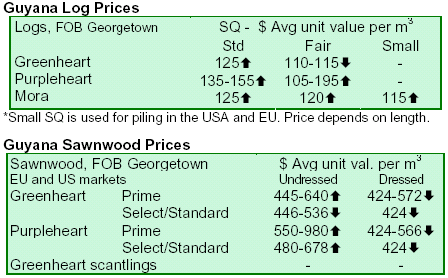
|